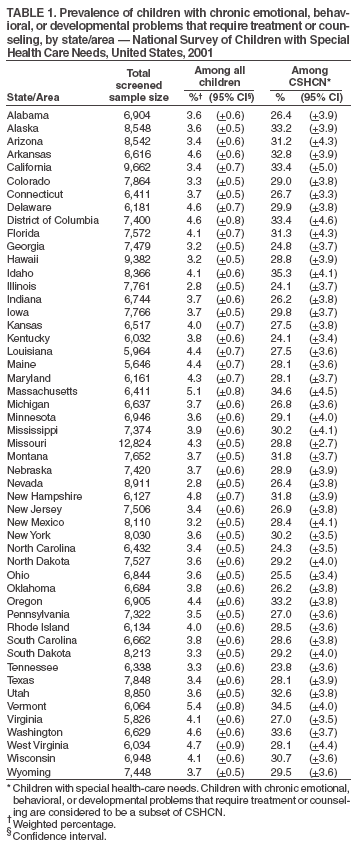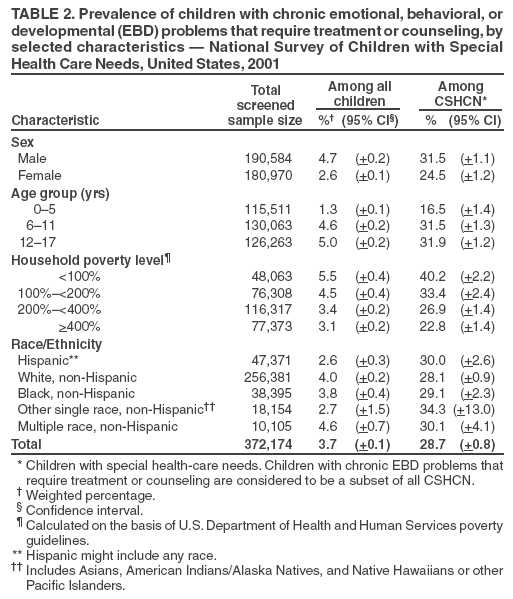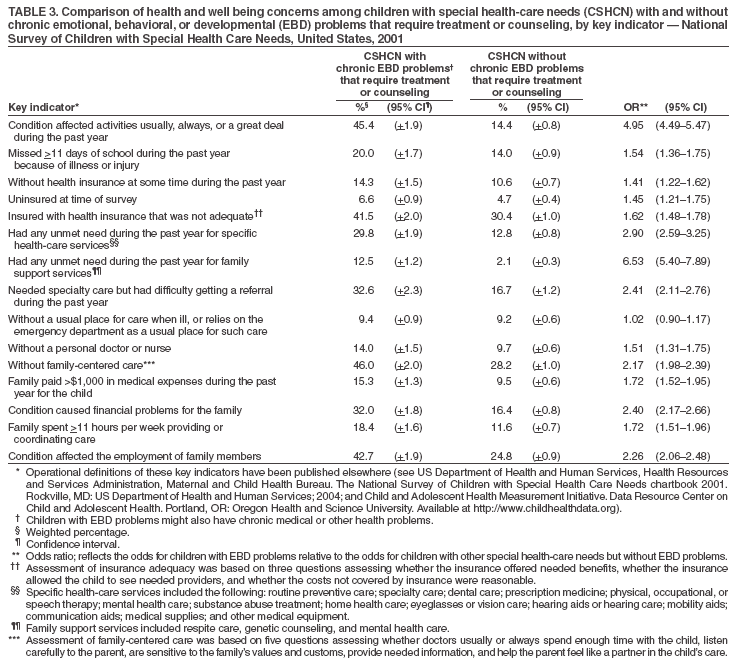 |
|
|
|
|
|
|
| ||||||||||
|
|
|
|
|
|
|
||||
| ||||||||||
|
|
|
|
|
Persons using assistive technology might not be able to fully access information in this file. For assistance, please send e-mail to: mmwrq@cdc.gov. Type 508 Accommodation and the title of the report in the subject line of e-mail. Mental Health in the United States: Health Care and Well Being of Children with Chronic Emotional, Behavioral, or Developmental Problems --- United States, 2001The needs of children with emotional, behavioral, and developmental (EBD) problems are a national concern. To assess the health care and well being of children who have chronic EBD problems requiring treatment or counseling, researchers from Oregon Health and Science University and CDC analyzed parent-reported data from the 2001 National Survey of Children with Special Health Care Needs. This report summarizes the findings of that analysis, which indicated that, compared with children with special health-care needs (CSHCN) who do not have chronic EBD problems, children with chronic EBD problems were more likely to experience diminished health and quality of life and to have problems accessing and receiving needed care. These children were more likely to have health conditions that affect their daily activities and cause them to miss school. In addition, their health-care needs were more likely to affect their families. The results of this analysis reinforce existing recommendations that encourage expansions in screening and early detection of mental health problems, as well as improvements in access, coordination, and quality of health-care services for children with EBD problems. During October 2000--April 2002, CDC conducted the National Survey of Children with Special Health Care Needs as part of the State and Local Area Integrated Telephone Survey (1). This random-digit--dialed telephone survey was sponsored by the Maternal and Child Health Bureau (MCHB) of the Health Resources and Services Administration. Parents or guardians of 373,055 children aged 0--17 years responded to a set of screening questions that permit identification of CSHCN (2). Screening questions were completed by 76.2% of parents contacted. CSHCN were defined as children who have "a chronic physical, developmental, behavioral, or emotional condition and who also require health and related services of a type or amount beyond that required by children generally" (3). Children with chronic EBD problems that require treatment or counseling (hereafter abbreviated as EBD problems) were considered to be a subset of CSHCN. A child was considered to be in this subgroup if the parent reported that the child needed or received treatment or counseling for an emotional, behavioral, or developmental problem and also reported that this problem had lasted or was expected to last >12 months (2). A child with EBD problems might also have chronic medical or other health problems. When a household with CSHCN was identified, one child with special health-care needs was randomly selected to be the focus of an interview about health status, types of services needed or used, access to care and characteristics of that care, health insurance coverage, and effect of the child's health on the family. Interviews were completed for 38,866 CSHCN, a 97.6% participation rate. Logistic regression analyses were used to compare the health care and well being of children with EBD problems with the health care and well being of other CSHCN without EBD problems. Children were included in this latter comparison group if their parents did not report EBD problems but did report that the children experienced at least one of four health or health-care consequences attributable to a medical, behavioral, or other health condition that had lasted or was expected to last >12 months. These consequences included 1) ongoing limitations in the child's ability to perform activities other children the same age can perform, 2) ongoing need for prescription medications, 3) ongoing need for special therapies, and 4) ongoing need for more medical, mental health, or educational services than is usual for most children the same age (2). This comparison group was not necessarily restricted to children with chronic physical conditions; the group might also have included children with chronic emotional, behavioral, or developmental problems not yet diagnosed or for which parents did not report that treatment or counseling were required. Data were weighted to reflect the noninstitutionalized population of children in each state and nationally (1). Among all children, 3.7% (95% confidence interval [CI] = 3.5%--3.8%; range among states: 2.8%--5.4%) had parent-reported EBD problems (Table 1). These children represented 28.7% of all CSHCN nationally (CI = 27.9%--29.6%; range among states: 23.8%--35.3%). Bivariate analyses indicated that the prevalence of EBD problems was greatest among children living in poverty (5.5%), adolescents aged 12--17 years (5.0%), and boys (4.7%) (Table 2). Compared with children with other special health-care needs, children with EBD problems were more likely to have 1) health conditions that affected their daily activities, 2) missed >11 days of school during the past year, 3) no health insurance or inadequate insurance, 4) unmet needs for health-care services, 5) difficulty obtaining referrals, and 6) $1,000 or more in annual out-of-pocket medical expenses (Table 3). Children with EBD problems were also more likely not to have a personal doctor or nurse and not to receive family-centered care. In addition, children with EBD problems were more likely to have family members who 1) experienced financial problems related to the child's health, 2) reduced work hours or stopped working to care for the child, and 3) spent >11 hours per week providing or coordinating health care for the child. Reported by: CD Bethell, PhD, D Read, MPH, Oregon Health and Science Univ, Portland. SJ Blumberg, Div of Health Interview Statistics, National Center for Health Statistics, CDC. Editorial Note:Nationally, 12.8% of children have special health-care needs (4). Title V of the Social Security Act calls for community-based systems of services to meet the needs of these CSHCN (5). This analysis of data from the 2001 National Survey of Children with Special Health Care Needs suggests that children with EBD problems constitute a substantial subgroup of CSHCN and are at increased risk for not receiving the services and support they and their families need. This increased risk might be attributable to multiple factors. EBD problems often are not diagnosed early, and children with these problems often require treatment and counseling that is more difficult to access than other types of health-care services (6,7). EBD problems usually do not have well-defined, evidence-based treatments (7). In addition, compared with other CSHCN, children with EBD problems can have multiple identifiable conditions (e.g., depression, anxiety, attention deficit hyperactivity disorder, and obsessive-compulsive disorder) that require multidisciplinary care, which is often poorly coordinated and not consistently available. Data on specific diagnoses are not available from the 2001 National Survey of Children with Special Health Care Needs, but estimates from the 2003 National Survey of Children's Health (NSCH) (8) indicate several conditions common to children with EBD problems. According to parent reports of what doctors have told them, 53.5% of children with EBD problems have or have had attention deficit disorder or attention deficit hyperactivity disorder, 51.7% have or have had a learning disability, 43.5% have or have had depression or anxiety problems, 6.8% have or have had autism, and 55.7% have or have had a behavioral or conduct problem (9). Other EBD-related conditions were not addressed by NSCH, but EBD problems as defined in this report also presumably include complex conditions such as Down syndrome and pervasive developmental delay. Many children with EBD problems also have comorbid chronic physical conditions. Parents participating in the NSCH reported that two thirds of children with EBD problems have or have had conditions such as asthma, allergies, diabetes, frequent headaches, hearing or vision problems, or bone, joint, or muscle problems (9). For children with EBD problems, these comorbid conditions might be related to their decreased likelihood of receiving needed services and support. Alternatively, the consequences of chronic physical conditions might be exacerbated by comorbid EBD problems. The next National Survey of Children with Special Health Care Needs (being conducted in 2005 and 2006) will include questions on functional status and chronic conditions, which might be useful for researchers interested in studying the effects of EBD problems on physical conditions among CSHCN. The findings in this report are subject to at least three limitations. First, the prevalence estimates of children with EBD problems (Table 1 and Table 2) are lower than certain other estimates of the prevalence of mental and behavioral health problems (6,10). This lower rate was expected, given that this report limits the prevalence estimate to children whose parents report an EBD problem that is expected to last >12 months and for which the child currently needs or receives treatment or counseling. Other prevalence estimates do not necessarily apply such restrictive criteria. Moreover, because a delay between the onset of symptoms and diagnosis is common for EBD problems, prevalence estimates for EBD problems might be higher if those estimates are based on reports of symptoms or behaviors rather than reports of conditions for which children require treatment or counseling. Second, these estimates were derived from parent evaluations of their children's health-care needs. Biases in parent reporting might exist, and parents might not recognize certain problems or consider certain problems to be EBD in nature, might not consider various EBD problems to be sufficiently serious to warrant treatment or counseling, or might not be aware of available resources and services for their children. Finally, the data were restricted to the noninstitutionalized population of children living in households with telephones, although weighted estimates reflect the population of noninstitutionalized children living in households with and without telephones. The results of this analysis support conclusions of national reports that recommend national, state, and local action to improve care and reduce disparities among children with EBD problems (6,10). To promote emotional, behavioral, and cognitive development through early recognition and effective intervention, CDC, MCHB, and other public health agencies have launched such initiatives as the "Learn the Signs. Act Early." campaign (http://www.cdc.gov/ncbddd/autism/ActEarly) and the Bright Futures in Practice: Mental Health guidelines (http://www.brightfutures.org/mentalhealth/index.html). Barriers to early detection and care for children with EBD problems must be removed to ensure good health care for children and families. References
Table 1  Return to top. Table 2  Return to top. Table 3  Return to top.
Disclaimer All MMWR HTML versions of articles are electronic conversions from ASCII text into HTML. This conversion may have resulted in character translation or format errors in the HTML version. Users should not rely on this HTML document, but are referred to the electronic PDF version and/or the original MMWR paper copy for the official text, figures, and tables. An original paper copy of this issue can be obtained from the Superintendent of Documents, U.S. Government Printing Office (GPO), Washington, DC 20402-9371; telephone: (202) 512-1800. Contact GPO for current prices. **Questions or messages regarding errors in formatting should be addressed to mmwrq@cdc.gov.Date last reviewed: 10/5/2005 |
|||||||||
|